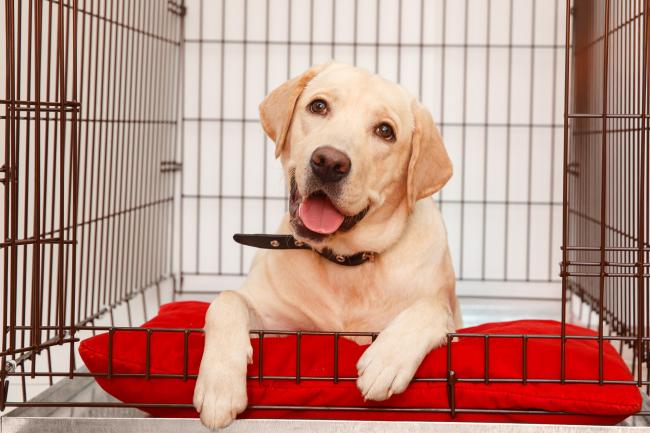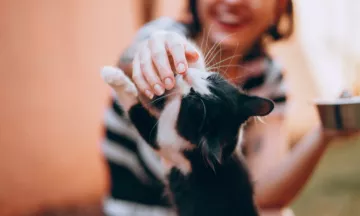A crate is a commonly used puppy training tool. But is a crate really necessary? And what risks does your dog run if you use a crate? Read all about when and how to use a crate for your puppy or adult dog.
What is a crate?
A crate is a cage or kennel in which you can lock up a puppy or adult dog. It is often used as a place for a dog to sleep and is widely used to housetrain puppies and prevent destructive behaviour. But is a crate really necessary? And what about if your puppy suffers from separation anxiety?
Toilet training with a crate?
It's a fact that puppies have a weak bladder. They often have to do small wees and also have to learn to pee outside and not inside the house.
The theory behind using a crate is that a dog will be toilet trained by not wanting to contaminate their own 'nest'. That's correct to some degree, however, young puppies up to 6 months old will occasionally lose a little bit of urine because they can't help it. By locking them up in a crate they will want to postpone this for as long as possible, but it is neither very healthy or comfortable for the puppy.
Watch all the signals from your puppy that tell you they have to go to the toilet, and take your pupper out every 2 hours. And as for the accidents in the home? Just use a mop and some organic detergent :-) Patience is key here!

Sleeping in a crate at night?
Many puppies howl, squeak and bark during the day or at night when they are alone. They do this because they feel lonely: they miss the comfort of their mother and siblings. Don't let your puppy howl or bark for too long - this can be harmful. Therefore, give your puppy the opportunity to sleep in different places, preferably near you. That way you give the dog the feeling of safety and security - instead of loneliness and stress. Never punish the dog for these normal emotions, but instead put them at ease. Read here what to do in case of separation anxiety.
Also try to discover which sounds and barks mean: "I have to pee!" so that you can also help your puppy go to the toilet at night.
Give your puppy a choice
Dogs, and especially puppies, regularly wake up at night and squirm around hundreds of times. It is important for the development of their muscles and joints that they can move freely and choose different places to sleep.
It is also important that your puppy can alternate between a warm spot (pillow, blanket) with a cooler spot (the floor, cool tiles) to manage their body temperature. You can leave the crate open at night so that the puppy can choose their own favourite spot.

Preventing destruction / chewing / scratching?
Dogs that chew furniture apart when they are alone are sometimes put in a crate to prevent this behaviour. This can actually have the opposite effect. Sure, the dog can no longer reach the furniture or your favourite pair of shoes, but the underlying cause of the destruction doesn't go away. A dog never chews furniture just to be annoying - there is always a cause, for example: stress, anxiety, or boredom or even a toothache.
Dogs that feel anxious or miserable when they are alone often chew on your stuff to release their stress. In a crate, they do not necessarily feel safer or less stressed: in fact, they have less freedom of choice and can, therefore, become extra frustrated. Many dogs eventually give up and go to sleep in a crate, but this is mainly because they simply have no other choice.
Many puppies start chewing the bars of the crate out of pure frustration. This can cause serious dental problems and a really dangerous situation if they get stuck with their teeth.
TIP: Do you want your puppy to keep out of certain places in the house? Place stair and door gates around your home. This way you give your puppy space but you still have control where they are allowed. Give your puppy enough safe chewing options with chew snacks, a rope or a Kong.
Read more about destructive behaviour here.
When is a crate useful?
A crate can be a useful tool for moving a dog It's good to let a dog get used to a crate in advance. A crate can be the perfect tool for your dog to travel to a new environment, such as to your dog sitter's house, as the crate is a source of homely comfort and familiarity.
A crate is also useful for short periods when it is safer for your dog to stay somewhere secure - for example, if you are moving house, if there are small children visiting, if you are going to clean etc.
Of course, you can use the crate as a cosy place for your pupper to sleep, but leave the door open.
How should you use a crate?
Make sure the crate is a nice and comfy place for your pooch. Put a favourite blanket and toys in there and maybe a piece of clothing that smells like you. You can reward your dog with a tasty snack in the crate so they know this is a safe and positive place.
However, also provide other sleeping places in the house for your dog. Many dogs like to get a little higher than floor level - that's why many dogs often choose to lie on the couch or bed. If you don't want your couch to get dirty, you can place a blanket on it where your dog can sit. There are many elevated dog beds for sale that your pupper will love.
Puppy sitting: a dog sitter for your young dog
Puppies have to get used to life outside the nest and in their new family. That means: lots of peeing, lots of sleep, lots of play and plenty of socialising.
A Pawshake dog sitter can help you during those busy first months in which your puppy constantly demands attention. Your pet sitter can come to your house to walk your dog, give love and cuddles and also to help with puppy training.
Using a dog sitter also brings the benefit of puppy socialisation. Your puppy needs to meet and have positive experiences with lots of different types of people when they are young, and a Pawshake dog sitter will allow this when you are busy at work. Read more about daycare for your puppy here.





